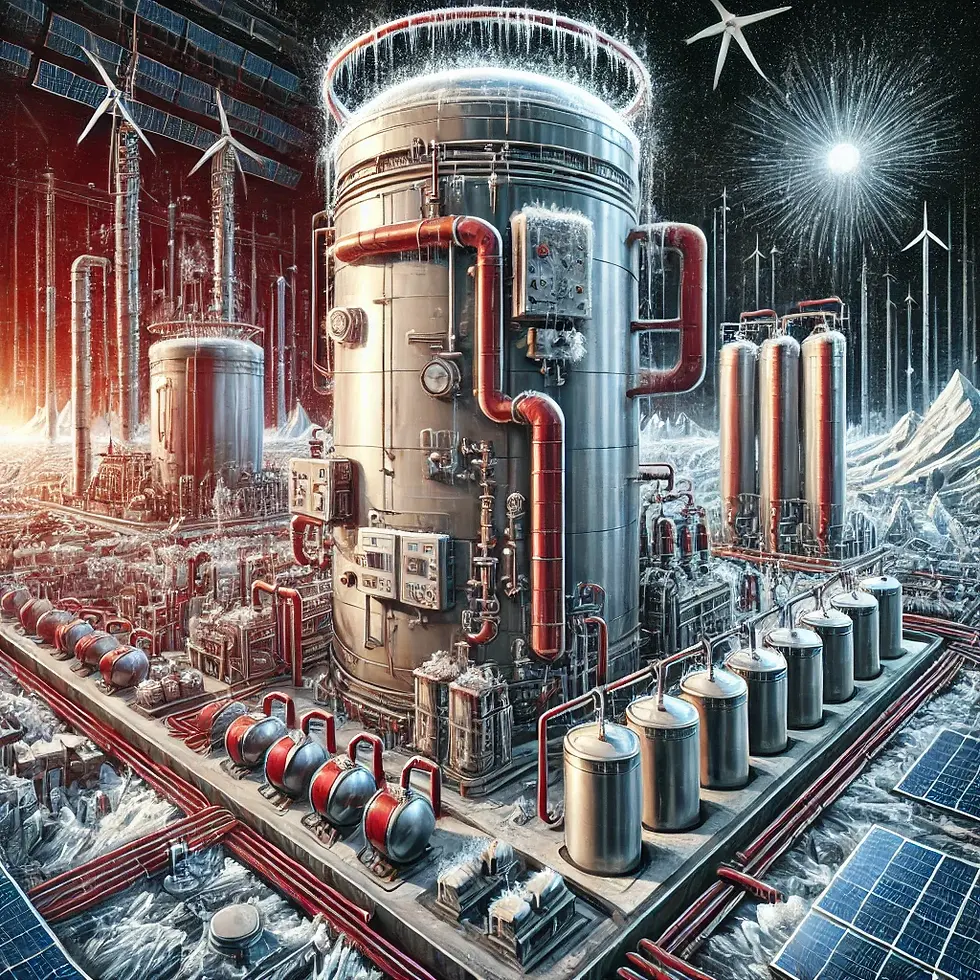Historic, Conventional and Futuristic Energy Storage
- TeOsTeam

- Mar 27
- 2 min read
Energy storage has evolved significantly over time, adapting to technological advancements and changing energy needs. Below is an overview of historic, conventional, and futuristic means of energy storage, categorized based on their development stages and applications.

Category | Technology | Efficiency (%) | Energy Density (MJ/kg) | Cost (USD/kWh) | Carbon Emissions (kg CO2/kWh) | Applications |
Historic | Firewood / Biomass | Low | ~15 | 10-30 | High (~0.5-1.5) | Heating, Cooking |
Historic | Water / Wind Mills | Moderate | N/A | 5-20 | Low (0) | Grinding, Pumping |
Historic | Ice Storage | Low | ~0.33 | 1-5 | Low (0) | Cooling |
Historic | Gravity Storage | Low | ~0.01 | 20-50 | Low (0) | Clocks, Irrigation |
Conventional | Pumped Hydro | 70-85 | ~0.5-1 | 100-200 | Low (0.01-0.05) | Grid Storage |
Conventional | Lead-Acid Batteries | 70-80 | ~0.03-0.05 | 50-150 | Moderate (0.1-0.2) | Automobiles, Backup |
Conventional | Lithium-Ion Batteries | 90-95 | ~0.2-0.26 | 150-300 | Moderate (0.05-0.15) | EVs, Electronics |
Conventional | Flywheels | 85-95 | ~0.1-0.2 | 200-500 | Low (0.01-0.05) | UPS, Frequency Regulation |
Conventional | Compressed Air Storage (CAES) | 40-70 | ~0.1-0.5 | 50-150 | Moderate (0.1-0.3) | Grid Storage |
Conventional | Thermal Energy Storage (TES) | 70-90 | ~0.2-1.0 | 10-50 | Low (0.01-0.05) | Heating, Cooling |
Futuristic | Hydrogen Storage | 30-50 | ~120 | 500-1000 | Moderate (0.1-0.3) | Transport, Long-Term Storage |
Futuristic | Solid-State Batteries | 95+ | ~0.3 | 300-600 | Low (0.01-0.05) | EVs, Aerospace |
Futuristic | Gravity-Based Storage | 80-90 | ~0.01 | 100-300 | Low (0) | Grid Storage |
Futuristic | Liquid Metal Batteries | 70-80 | ~0.2 | 200-400 | Moderate (0.05-0.15) | Grid Storage |
Futuristic | Supercapacitors | 90-98 | ~0.01-0.02 | 100-300 | Low (0.01-0.05) | Rapid Power Delivery |
Futuristic | Flow Batteries | 60-80 | ~0.04-0.08 | 400-700 | Low (0.01-0.05) | Renewables Integration |
Futuristic | Carbon-Based Storage | 95+ | ~0.3-0.5 | 500-1000 | Low (0.01-0.05) | Future Electronics |
Futuristic | Biological Energy Storage | Low | ~0.01 | Unknown | Negligible (0) | Wastewater Treatment |
The data presented here is derived from a combination of reputable sources, including academic research papers, industry reports, and technical publications from organizations such as the International Energy Agency (IEA), U.S. Department of Energy (DOE), and National Renewable Energy Laboratory (NREL). Specific numerical values for energy density, efficiency, and cost estimates have been compiled from various reports, such as the IEA's Energy Storage Tracking Reports, DOE's Energy Storage Grand Challenge Roadmap, and market analyses from consulting firms like BloombergNEF and McKinsey & Company. Additionally, real-world case studies and manufacturer specifications from leading companies in energy storage, such as Tesla (for lithium-ion batteries), Siemens (for compressed air storage), and Energy Vault (for gravity storage), have been referenced to provide the most accurate and up-to-date information. The historic storage methods were informed by historical records and energy transition studies, while futuristic technologies are based on ongoing research publications and experimental findings published in journals like Nature Energy and IEEE Transactions on Energy Conversion. Given the rapidly evolving nature of energy storage technologies, the values in the table represent current industry consensus and may vary with future technological advancements and market conditions.






Comments